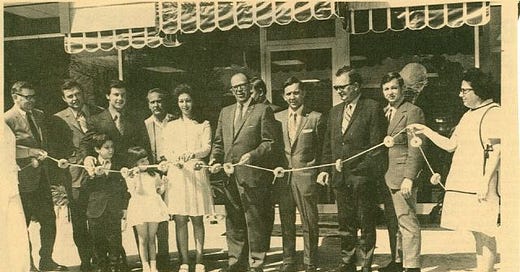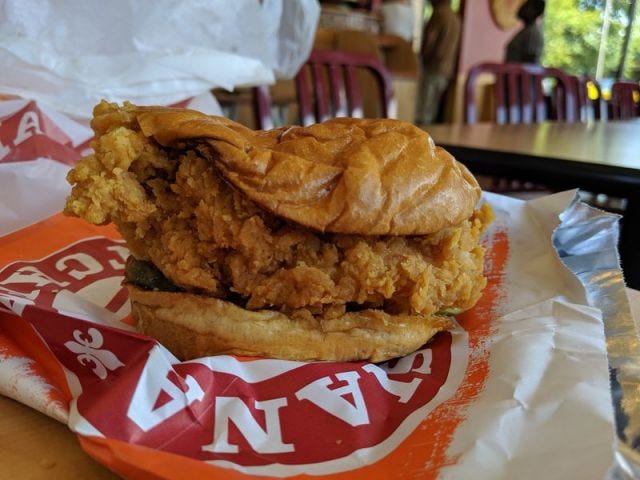Pecan-Praline Frosted Eclair, Mr. Ronnie’s Famous Hot Donuts – Houma, Louisiana
In 1962, Alvin Charles Copeland opened up a Tastee Donuts franchise in Houma, Louisiana. The franchise was a wedding gift from his brothers, which, to be quite honest, was more of a business decision on his brother Gil’s part, as he was looking to expand his Tastee Donut stores across the Southeast. The Tastee Donuts franchise in Houma was one of thirty-seven Tastee Donuts, and the only one that would be open for 24-hours. There was a grand ribbon cutting ceremony, complete with the entire Copeland family as well as the mayor of Houma dressed in their finest suits and Sunday dresses. The ribbon was threaded through approximately twelve donuts, suspended in mid-air, undoubtedly, before the string was cut, sending the glazed donuts tumbling to the hot Louisiana asphalt.
For Al Copeland, it was never about the love of donuts—instead, it was about the hunger for making one’s way in business. Nine years later, New Orleans opened its first Kentucky Fried Chicken restaurant, which had lines wrapped around the block, full of customers wanting to fill up on two-pieces. Looking to capture some of the fast-food fried chicken momentum magic, Copeland opened up a restaurant in Arabi, called Chicken on the Run in 1971. The restaurant failed, as it was just attempting to make the same chicken that was sold at KFC, but without the name recognition—furthermore, as with most brand-new franchises that are introduced to new markets, business had slowed down significantly since KFC’s launch, and ultimately plateaued. Copeland, ever the businessman, knew that he needed to do something new: he chose to lean into the familiar concepts of New Orleans cuisine, crank up the spice levels, and reopen as Popeyes Mighty Good Chicken. Within four years, and a quick name change to Popeyes Famous Fried Chicken, Copeland had begun franchising Popeyes, and the first casualty was his Tastee Donut franchise, which he sold in 1976.
The rest was academic: there were 500 Popeyes restaurants by 1985, and Al Copeland became a multimillionaire cartoon character, complete with extravagant Christmas light shows in Metairie, a power boat racing team, multiple gaudy weddings to increasingly younger women, a fist-fight over losing out on a gambling license, and, perhaps, most famously, a very public feud with novelist Anne Rice over Copeland’s decision to open a restaurant in an abandoned Mercedes-Benz dealership where Anne Rice’s most famous vampire, Lestat, finally sees his reflection and ceases to exist. New Orleans, am I right?
Popeyes, (there’s no apostrophe in the name, by the way—Copeland claimed he was “too poor” to afford an extra glyph in his signage) has been the talk of the culinary zeitgeist these past few weeks with the release of their Chicken Sandwich: a limited edition item that made the Internet lose their ever-loving minds. The sandwich is good—really good, in fact—and made all of the better because of the world’s awkward relationship with Chick-Fil-A & their donations to blatantly homophobic causes, thus giving chicken sandwich lovers an alternative that makes them feel less guilty about their consumption. Today, Popeyes announced that there will be a temporary halt on serving the Chicken Sandwich due to a lack of product, though to soften the blow slightly, Popeyes revealed that the Chicken Sandwich will be a permanent menu item, taking its rightful throne atop the LED boards alongside the Signature Chicken and the Spicy Tender Combo (my personal favorite, with a side of red beans, hold the rice).
This is a limited-edition success story: one where the demand for the product is so unbelievably popular that it has broken through the allocated temporal space into something etched in stone, or at least given a proper combo menu item number. As with most frenzies, as soon as the Chicken Sandwich ascends to the regular menu item rotation, these things will die down; one of the running jokes during this Chicken Sandwich debate were people unfamiliar with the organized chaos that is Popeyes (a friend said it better than I ever could: Popeyes doesn’t give you what you want, Popeyes gives you what you deserve) complaining that the entire restaurant was in disarray, not realizing that this is part of Popeyes charm: folks used to the my pleasure’d cult of Chick-Fil-A aghast at finding a popcorn shrimp in their fries, or having to wait fifteen minutes on spicy, or asking for Mardi Gras Mustard and getting a half-opened Buffalo Sauce. It’s not a bug, it’s a feature.
I am a Popeyes chicken lover. I eat there at least once a week, sometimes twice. It has been wild to see this sudden surge of popularity and focus on a space that I consider holy—enough for me to steer completely clear from my usual Northport Popeyes location for the past two weeks in hopes that things will eventually cool off. I’ve chosen to laugh off the Popeyes amateurs because it is what I am used to doing; it makes me feel good that I have been in the secret club for all of this time, and now everyone is trying to figure out the speakeasy password that I have memorized by heart.
This frenzy for limited-edition and hard to obtain food items is no stranger to those who obsess over donuts. There was the great Cronut rush of 2013. Many shops have special flavors that run out fifteen minutes after the shop opens, so you need to get there early. “You could say the donut has become a canvas for innovation. We’re really seeing a donut renaissance,” says Darren Tristano, president of a restaurant industry research firm. Fresh donut sales have risen an average of 5.2% per year. They are the number one baked good consumed away from home in the United States. But what is most interesting is the rise of the artisanal donut: while basic mom & pops shops have been dotting the baked good landscape for decades, donut shops with a constantly rotating menu have taken over the industry and quickly are the “go-to” hot spots whenever I am asking for donut recommendations when I travel to a new location.
The key to these donuts, of course, is their temporal nature: donuts, after all, don’t travel particularly well. Every Saturday I buy a dozen donuts with the knowledge that I’m never going to make it through them all—by Sunday morning they have been exposed to the elements too long and have gotten hard and crumbly. This “here then gone” mentality corresponds perfectly to the “seasonal” or “limited edition” varieties—ingredients that one wouldn’t necessarily find every single day, or flavor combinations that for some reason just taste better when it is 15 degrees outside rather than 90. Mojo Monkey Donuts in St. Paul, Minnesota, one of my favorite “artisan” donut places on this planet, has a different donut for the twelve days of Christmas: the day that I was there they offered a “Seven Swans A-Swimming” donut, a Camembert and Cherry-Cream filled Bismarck, topped with a dark cherry ganache, edible glass, and sugared rose petals. Krispy Kreme has had some amazing success with its “Chocolate Glaze Days,” where on the first Friday of each month, they switch the regular glaze on their Hot Now Original Glazed Donuts with a chocolate glaze. It is officially Pumpkin Spice season, and Dunkin’ is offering their excellent Pumpkin donut, as well as an Apple Cider variety. The business of limited-edition is profitable too: specialty donuts at Dunkin' and Krispy Kreme are sold at a higher price point than their originals. And most artisanal donut shops have a tiered pricing system; the executive chef of Federal Donuts in Philadelphia has admitted that the fancier donuts are far more profitable than their basic fare. This seems somewhat counterintuitive to how I imagine basic economics works, but again, it seems to come down to the idea that donuts are temporary things. A zucchini and thyme flavored donut probably isn’t what anyone would want, but we are willing to try and pay for it, solely for the sake of saying that we tried it—the same way that I don’t particularly like chicken sandwiches, but I’ll be damned if I wasn’t going to get my hands on one of Popeyes’ newest creations.
(Seven Swans A-Swimming Donut, bottom right)
At some point the artisan donut bubble is going to burst. There are only so many donut-shaped inflatable tubes that can fit into the pool. I, for one, welcome it. A Forbes article from 2016 interviewed the owners of Blue Dot Donuts in New Orleans, who opened their business because the owner “negotiated a good rent on it.” "We are willing to try anything on a donut," Ronnie Laporte, the owner stated. "We once entered a local festival and smoked some pork butts and put it inside of our unglazed éclair style bun. We added an Asian slaw and won the best meat category.” Laporte sold his business less than a year later. “I’m ready to move onto something else.” A quick Google search reveals that Laporte has gotten into the wine business.
Other donut shops have begun to hedge their bets—the aforementioned Federal Donuts also sells Korean twice-fried chicken at its multiple locations. Chicken is a famous pairing: there’s Astro Doughnuts and Chicken in Washington D.C., and Blue Star Donuts in Portland offers a fried chicken topped donut.
While I love Federal Donuts (and their za’atar chicken is good too!), I have not had a worse donut than at Blue Star and at Astro. My dozen donuts at Astro cost me $42 before tip, and were over-fried dry messes with a distinct burnt flavor to everything (minus, ironically, the crème brûlée donut). I spent $16 on three donuts at Blue Star, which was a donut shop trying too hard not to be a donut shop, including a giant sign that read “Doughnuts for grown-ups,” which instantly turned me off. In Blue Star’s case, they added flavors just for the sake of adding a flavor: whether that was taking a vanilla spice donut and dousing it in cardamom, or adding bergamot tea to a perfectly fine chocolate donut, or only offering a “horchata glaze,” as their most basic donut. It seemed as if in their quest to create a “memorable” donut, they lost everything that makes a donut great, namely, that it tastes good and fulfills a certain pleasurable need.
Perhaps this is my problem with the artisanal; the Center for Urban Education about Sustainable Agriculture held a panel titled “Scaling Up Artisanal Food,” which outlined the parameters culinary artists should adhere to when using the artisanal label. One of the key sticking points is innovation in moderation, and how the term “handcrafted,” should not be at odds with the well-being of the product as well as those who make said product—that being difficult for the sake of being difficult is not what true artisans do; that if there is a way to use technology or mass-production for the sake of a better product and a happier work environment, culinary artists should have an obligation to do so. But the thing that stuck out most to me in this panel was when June Taylor, who makes small-batch preserves, talked about needing to be flexible with how fleeting food can be. “The personality to stay with your product after you see it destroyed…it’s just amazing.”
Perhaps Al Copeland saw something more permanent in the consumption of chicken than he did with donuts—that maybe the sight of a thigh bone bleaching in a Metairie parking lot grounded him in a way that leftover sugar on sticky thumbs did not. Or, he just recognized donuts as bad business, the same way that the original owners of Blue Dot did, or how Dunkin' famously pivoted to coffee in 2018, or how overpriced artisan donut places have to continue to churn out exotic flavor pairings to middling results in order to keep an Instagrammer’s curiosity piqued.
Al Copeland sold Houma Tastee Donuts Franchise #28 to Ronnie Picou in 1976. For eight years, Ronnie operated Tastee Donuts, but eventually grew frustrated from the lack of support from higher management, (Gil Copeland, original owner of the brand, had sold everything and put everything into Popeyes) and shuttered his doors. However, ten years later, he decided to re-enter the donut business, opening his own store: Mr. Ronnie’s Famous Hot Donuts, presumably stealing the idea of inserting “famous,” into the shop’s name from Copeland. You won’t find chicken at the donut shop, but you will find burgers, sold only during the lunchtime hours, or until they run out of ingredients. Mr. Ronnie passed away this year at the age of 79. The inscription on his tombstone reads “I am a gone pecan.” When asked about the saying, his daughter said it was something that Mr. Ronnie said after a long day of crushing and grinding pecans for a pecan-praline frosted eclair that he offered in the fall—taking advantage of whatever gifts the earth gives, if only for a limited time.







